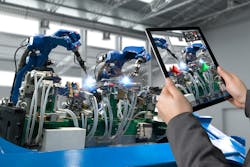How SMBs Can Establish Maintenance and Repair Practices
This article is part of the System Design Series: From Design to Delivery: Creating Embedded System Solutions.
What you’ll learn:
- Steps needed for successful reactive maintenance.
- When it makes sense to plan maintenance in advance.
- How to utilize new technologies for successful predictive maintenance.
The maintenance and repair of equipment in industrial environments are both productivity and safety concerns, with significant hidden costs on both fronts if not managed well. When something breaks, business opportunities are lost while production is on hold. But beyond company productivity, regular maintenance is critical in providing a safe and healthy workplace. Lack of maintenance, or inadequate maintenance, can cause serious or deadly accidents and health problems, often resulting in costly penalties and legal action.
In this final article in our series, we look at how small- and medium-sized businesses (SMBs) can establish maintenance and repair practices in three key areas: reactive maintenance, planned maintenance, and preventative maintenance.
Technology is helping maintenance evolve from an after-the-fact activity to something that’s predictable. New developments in sensor technologies, virtual and augmented reality (VR/AR), cloud-based platforms, and AI-enhanced analytics can provide better data on performance levels and help manage maintenance without losing equipment efficiency.
Reactive Maintenance
Reactive maintenance involves repairs done to equipment that has failed and caused disruption (Fig. 1). Arguably the greatest challenge encountered by SMBs when repairs are needed is the availability of parts and expertise. If a part number is unknown or the part has become obsolete, SMBs can often face the difficult decision of replacing a machine.
The first step is finding a one-stop shop for sourcing parts with a distributor that keeps required components in stock. A broad line distributor can help SMBs avoid wading through multiple supplier sites to find what they need.
And it’s not about just having the broken part in stock. SMBs will also need access to the tools, test equipment, and ancillary components (e.g., wires, connectors, adapters, etc.) to get the equipment running again.
Lastly, it’s not enough to have the parts necessary to fix broken equipment. They need the expertise to support the sourcing and repairs. A good broad line distributor will have specialists in-house who can find the products businesses need, or know which alternatives will work should that part become obsolete.
It’s also critical to have an expert on call to help you with the repairs. Having 24/5 live technical support with trained specialists can mean the difference between an expedited fix and a protracted work stoppage.
Planned Maintenance
Planned maintenance refers to maintenance activities that are scheduled and recurring based on known wear-and-tear needs of equipment (Fig. 2), much like car owners getting oil changes every 3,000 to 5,000 miles. As with reactive maintenance, a one-stop shop for parts and expertise is an enormous asset.
But the needs may be different. First, SMBs with planned-maintenance schedules have probably ordered the same parts repeatedly in the past. And if they previously ordered a lot of parts, it can be difficult to know what they need. A good distributor has purchase records and knowledge to track down their requests.
Similarly, having access to kitting services can be an enormous asset to SMBs. When conducting planned maintenance on a regular schedule, searching for the same products, again and again, is a productivity waster. Access to custom kitting operations can keep the products they need always at the ready.
Planned maintenance requires safety precautions. SMBs should look for sources that offer the personal protection equipment (PPE) to perform all maintenance operations. They should also offer a broad selection of test equipment, spanning electrical, environmental, and mechanical tools, to test the functionality of their work. They should have access to a variety of cleaning and lubrication supplies as well.
Predictive Maintenance
Predictive maintenance uses data analytics to detect possible anomalies and defects in equipment so that businesses can address them before they fail (Fig. 3).
AI and machine learning are key enablers of predictive maintenance. Leveraging sensors and other forms of data collection, predictive maintenance draws from actual measured equipment usage, operating conditions, and equipment feedback to generate individualized predictions of impending issues. The goal is simple: Intelligently analyze massive amounts of disparate, real-time data to predict when a machine might fail so that manufacturers can keep their operations running uninterrupted.
The good news is that equipping production systems for predictive-maintenance monitoring is easier and less costly than ever before. “Bolt on” systems are now prevalent, enabling companies to attach modules to their equipment.
Maintenance and Repair of Existing Production and Manufacturing Environment
When something breaks, if a part number is unknown or it’s an obsolete part, small businesses face the difficult decision to replace an entire machine. But high-end distributors have the ability to identify the necessary part to replace and chase down replacement parts for products that are no longer sold.
Maintenance is not only necessary to ensure the reliability of technical structures or productivity of the company, but regular maintenance has an important role in providing safer and healthier working conditions.
The maintenance function is evolving from being after-the-fact, to planned, to predictive. Developments in operational sensor technologies, combined with advances in information technologies including VR/AR, cloud-based platforms, and analytics, are helping to provide real-time data on performance levels and outline predictive or scheduled maintenance without losing equipment efficiency.
About the Author

Cliff Ortmeyer
Head of Solutions, Newark
Cliff Ortmeyer holds an electrical engineering degree and has worked in the electronics industry for 26 years in a variety of engineering and marketing management positions. He’s been with Newark for six years, most recently as the Global Head of Technology Product Marketing and Solutions Development. Previously, Cliff worked for STMicroelectronics and Coilcraft in positions ranging from Applications Engineering to Market and Business Development.
Cliff holds multiple patents and is an electronics enthusiast with a passion for understanding and leveraging new technologies. His current focus is on the role of new technologies and trends and how they impact the future of developing new markets like IoT through makers and engineers alike.



